Step 1: The Discovery
It was a complete accident that I found Wikipedia's book creator feature. I was looking at a Wikipedia page I'm embarrassed to mention. Alright, I'll mention. It was Hilary Duff's Wikipedia page. I have this problem where I attribute a lot of Hilary Duff's great work to one Avril Lavigne, and vice-versa. If either of those young ladies are reading this article, I deeply apologize. You're both really great at...you're not the same person.
After answering some of my burning questions (Is Hilary Duff Avril Lavigne? Are you sure?) I scrolled deeper into Duff. I wondered, if there's this much info, how many references were used to build this page, this treasure trove of information? 149 if you're curious. If you're curious about how that scales, Ernest Hemingway has 201, Ernest Borgnine has 27, and Jim Varney, who played Ernest in the Ernest Goes to... movies has 16. Joseph Conrad, who isn't named Ernest, has 48. The man who wrote Heart of Darkness has 101 fewer references than Hilary Duff, the woman who wrote elixir.
While I paged through other famous artists in order to make myself sad (Melville: 120, Denis Johnson: 22, Mary Oliver: 11), I saw this little chunk in the column off to the side.
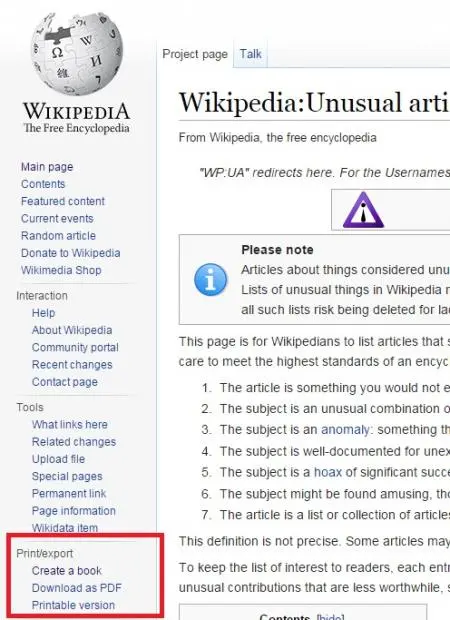
I had side-by-side Wikipedia windows of Hilary Duff and Joseph Conrad. Rather than provide a reason for clicking on the Create a Book link, I'll just say that there were damn few reasons not to click anything at this point.
The link took me to this page, where you can add pages to a book and order a printed copy! An actual, printed book for people to read.
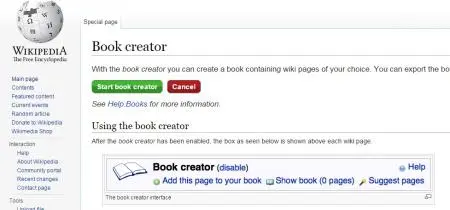
The collector side of me rejoiced. This part of me that was dormant for a long time, since the days when I gathered and sorted baseball cards, including a cherished card featuring a topless Kirby Puckett. The collector in me loved the idea of this new type of collection, this new form of curation. The eclectic side of me was pumped too. The more ridiculous side that put X-Men cards, Nintendo cards, and Desert Storm cards in the same album alongside the scantily-clad Mr. Puckett. Both sides of me met, shook hands, and then did an adult version of shaking hands that I won't get into here. It was an exciting moment. Like my hero John Hodgman, and like a bunch of people who were my enemies and designed the terrible textbooks that were slapped together in order to prevent sane people from finishing college, I was going to put together my own book, My own miscellany.
Who's writing history now, David Kennedy, author of that damnable The American Pageant textbook?
Step 2: What? Why?
You might not be like me. You might not be the kind of person who delights in the thought of cramming a bunch of insane Wikipedia articles together into a bizarre mish-mash and then giving them out to friends and family for Christmas. You might not be a person who spends a lot of time looking at the lives of former Disney stars on Wikipedia. I can acknowledge that there might be some weirdos out there who don't care about the marital status of Hilary Duff. Wait, no. Avril Lavigne. Either.
So why would you want to make your own Wikipedia tome?
PediaPress, the company behind the endeavor, uses the example of someone creating a gift for a friend who is sailing around the world. You could make this friend a book about the places she'll see, the history of sailing. You could give someone traveling a long way in a harsh environment a piece of print material to ruin. This is an opportunity not to be missed!
In this scenario, I would advise that, in addition to destinations and sailing techniques, you also add some terrors of the sea. Maybe Sloane's Viperfish or a nice Anglerfish will do. Let's face it, if I'm sitting at my desk while my friend is sailing around the world, I'll sleep better at night knowing I've introduced some terror into her life.
Just in case your friends aren't jerks who sail around the world, I have some other possibilities:
You can make a point like a real ass.
Ever had an argument where you were right? And now you're looking for a great way to continue rubbing it in someone's face? How about a printed book?! The recipient is sure to remember whether Avril Lavigne or Hilary Duff is responsible for "sk8r boi" after receiving a handsome volume about the two stars and their various discographies. That's the last Hilary Duff reference, swear to god.
You can read Wikipedia on the toilet.
Poop reads, as they're known here at LitReactor. Don't risk your tablet near your bathroom's open water. Print up a tome and let the magic of Wikipedia take you away. Perhaps the Bristol Stool Scale, a chart that categorizes human waste, would make for appropriate reading.
You can create your own textbook.
Ever took a class and left feeling like you never covered the most exciting stuff? Wait, let me revise that question. Ever take a class? Now you can create your own textbook for your own curriculum, and now you can be sure the Emu War of 1932 and all its machine-gunning-of-birds glory is covered in your very own Australian History textbook.
You can make a lovely gift.
Imagine. An anniversary gift with pages all about you and your sweetheart. The place you went on your first date. A story about the history of menudo, the food you ate on your first dinner together. An informative look at Taenia saginata, the fascinating little parasite that improperly cooked beef entrails are likely to harbor. Nostalgia, science. Ah, what a romantic gesture!
You can go deep on any subject.
The McDonaldland page alone. A few key entries:
Iam Hungry – A short-lived McDonaldland character who was the self-proclaimed "Vice President of Snacking".
Officer Big Mac – Featured in several of the campaign's commercials throughout the early 1970s and early 1980s. He was similar to Mayor McCheese in that he had a large Big Mac for a head (minus the vegetables and the special sauce), except he was the chief of police and as such he wore a constable uniform with a disproportionately small custodian helmet resting atop his head bun
Uncle O'Grimacey – Created in 1977 and first appeared in 1978 for an advertising narrative of McDonald's, both in celebration of Saint Patrick's Day and to mark the annual appearance of the Shamrock Shake. O'Grimacey was the Irish uncle of Grimace and was a variant of the Grimace-design in that he was green instead of purple, sported a waistcoat covered with several four-leaf clovers, and carried a shillelagh.
It's good for writing research.
I did, actually, have a writer-ly purpose for this. I've been working on a longer piece featuring an astronaut, and the more I could learn about space, the better. Creating your own Wikipedia tome gives you access to that material in a simple format that's really easy to mark and get back to. Space colonization questions? No problem. Robot-assisted space colonization? Even less of a problem!
Step 3: How
Once you decide to join me in this greatness, click on the "Create a Book" link on any Wikipedia page and then click the "Start Book Creator" button. You'll see this toolbar added to the top of every Wikipedia page you visit (boxed in red here for your ease):
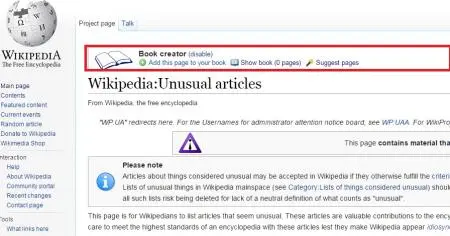
When you hit a page you like, just click the green plus sign to add it to your book. The middle "Show Book" option will track the number of pages you've added, and on the far right you've got suggested pages, which is helpful if you're putting together a book on a rational topic, not so much when you're seeking out oddities like The Cardrona Bra Fence or a brief article on the life of the unfortunately named Dick Assman.
Once you've got your book creator started, surf with care. And then without a care in the world. Because there is some seriously great stuff out there, including people with names almost as hilarious as Dick Assman. If you need a place to get started, or if you just want to kill an afternoon or 30, I recommend the List of Unusual Wikipedia Articles.
Here are some basic tips I learned when creating my book. This is hard-won knowledge that resulted from some serious clicking hardships that haunt me to this day, much like the peak of Koh-i-Chiltan is said to be haunted by 40 ghost babies.
Fast Add
You can add articles quickly by hovering over the title. You don't have to click and add from the individual pages. Instead, just hover and click.
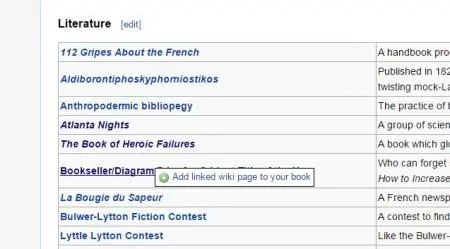
Do Not Dawdle
Time is of the essence. I can't give you an exact number, but at some point, the cookies crumble and pages in your book will disappear. It's not a terribly tight timeline, but if you leave your computer idle for a half hour, chances are you'll have to start anew. Keep up the pace, unlike the song "As Slow As Possible."
Pick at least one article with a good image
You'll be able to pick from the article images for a book cover, so it'd be wise to have at least one cover-worthy image locked down. http://en.Wikipedia.org/wiki/Flesh_fly has a picture of flies having sex. Just saying.
Order Is Key
Before you publish, you can alter the order of your book. If your articles are going in a particular order, like a finely-tailored mixtape meant to demonstrate love, but cool love, not weirdo love, make sure and order them properly before you publish.
Page numbers don't equal page numbers
When you add a page, you add a printed 8.5"X11" page. When the book creator reformats, you'll end up with a much larger number.
Step 4: Pressing
You've finished adding pages. You selected the "Show Book" option from the menu that hovers at the top of every page you click. You put the articles in the proper order. You made sure to include the entry for Inventors Killed By Their Own Inventions, which is an important and all-encompassing entry because it covers hubris (Karel Soucek, inventor of a stunt barrel), irony (Li Si, inventor and victim of the 5 Punishments method), sadness (Marie Curie) and the bizarre (Scottish Maiden, which allowed stolen animals to wear the executioner's hood).
You added a title, perhaps by looking at the Bookseller/Diagram Prize for Oddest Title of the Year listing.
You've assembled your tome. It's time to push the Order as a Printed Book button.

As a quick note, you do have the option to grab the PDF instead. If you're cool with an electronic version, then you're all set. If you're a print and paper fiend, my advice is to go with PediaPress. They aren't paying me anything to say that, and LitReactor isn't in some kind of gross business partnership with them. I'm just telling you, from personal internet perusal, that it comes out a lot cheaper and easier if you go PediaPress than shopping the PDF around
Step 5: Go back a few steps?
My first run through, my book came in at an alarming 687 pages. Which isn't alarming so much as costly. At $38.25 apiece, it would be tough to order these suckers for friends and family as a holiday gift. My options were to make some reductions in my tome or in my friends. So it was goodbye to Goose Pulling, which is pretty gross anyway. See you later, Bigfoot Trap. See you in hell, Stephen, who isn't a Wikipedia entry but a friend. Hey, I had two options to bring my costs down, and I took both. That's just good sense.
If you, like me, find that your book is of crazy length, my advice is to go back through and eliminate those entries that have large reference/external links sections when compared to their article size. From what I can tell, you can't leave those off, so your best bet is to reduce the articles with tons of sources.
Sigh. Later, Hilary Duff.
Okay, THAT was for real, the last Hilary Duff reference.
After cutting my team like a ruthless high school football coach, who almost always seems to have a southern accent in the movies, I got down to a reasonable $24.45/book.
Step 6: The Arrival
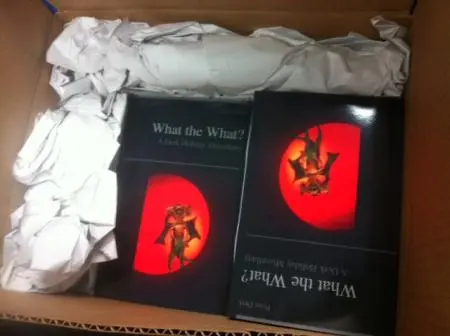
And then, they arrived. What the What: A Derk Holiday Miscellany hits the shelves (of family and friends) this December. Whether they're happy about that fact or not.
I checked out the binding and flipped through the finished product. Honestly, it looks pretty great. It's well-bound, the paper is good quality. The image of Jenny Haniver on the cover turned out beautifully.
Overall, this is a great experience I highly recommend. It makes an awesome gift for the person who has everything, like the Collyer Brothers, famous packrats who went so far as to boobytrap their collection.
My advice? Go forth and chase those dreams. Who knows, maybe you'll inspire someone to finally solve the self-balancing unicycle conundrum. Maybe your content will bring out the chess boxer in someone you know. Or, if you're lucky, you'll inspire a duo of great mathematicians like David A. Cox and Steven Zucker, creators of the Cox-Zucker machine.

About the author
Peter Derk lives, writes, and works in Colorado. Buy him a drink and he'll talk books all day. Buy him two and he'll be happy to tell you about the horrors of being responsible for a public restroom.







